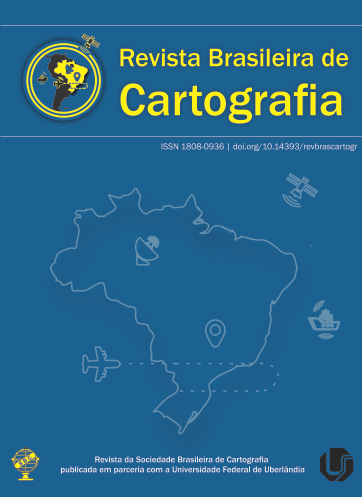30 anos de Medições Gravimétricas Absolutas no Brasil
Conteúdo do artigo principal
Resumo
O Sistema Geodésico Brasileiro é composto por estações de referência que reúnem informações acerca da componente altimétrica, planimétrica (geocêntrica em uma definição contemporânea) e gravimétrica. Essa última componente, que nesta década alcançou maior evidência em função dos acontecimentos que a envolve, exerce um precípuo papel em áreas como a Geodésia, a Geologia e a Geofísica. Destacam-se os novos valores de altitudes de referência, baseados em números geopotenciais, apresentados pelo Instituto Brasileiro de Geografia e Estatística em julho de 2018, bem como os esforços que estão sendo despendidos para a implantação de um Sistema Internacional de Referência para Altitudes. Face ao exposto, o objetivo deste trabalho é mostrar o que o país possui em termos de medições gravimétricas absolutas, levantadas desde 1989 com a implantação da Rede Nacional de Estações Gravimétricas Absolutas. Um destaque evidenciando a remedição da referida rede, bem como os atuais esforços gravimétricos no país é apresentado. Além disso, realiza-se uma revisão sobre os métodos de medições absolutas, bem como os gravímetros empregados nesses 30 anos. Por fim, traça-se uma relação entre a distribuição de estações absolutas no país com as estações que comporão o Sistema Internacional de Referência para Altitudes.
Downloads
Detalhes do artigo
Seção
Autores que publicam nesta revista concordam com os seguintes termos:
- Autores mantém os direitos autorais e concedem à revista o direito de primeira publicação, com o trabalho simultaneamente licenciado sob a Licença Creative Commons Atribuição que permite o compartilhamento do trabalho com reconhecimento da autoria e publicação inicial nesta revista.
- Autores têm autorização para assumir contratos adicionais separadamente, para distribuição não-exclusiva da versão do trabalho publicada nesta revista (ex.: publicar em repositório institucional ou como capítulo de livro), com reconhecimento de autoria e publicação inicial nesta revista.
- Autores têm permissão e são estimulados a publicar e distribuir seu trabalho online (ex.: em repositórios institucionais ou na sua página pessoal) a qualquer ponto antes ou durante o processo editorial, já que isso pode gerar alterações produtivas, bem como aumentar o impacto e a citação do trabalho publicado (veja "O Efeito do Acesso Aberto").





